Abstract
An enzyme linked immunosorbent assay (ELISA) has been developed to quantitate faecal Clostridium perfringens enterotoxin in the investigation of C perfringens food poisoning. The sandwich ELISA could be carried out in 24 h and was sensitive enough to detect as little as 5 ng/g of enterotoxin in faeces. Specificity of the assay was shown by comparing results with those obtained from other standard toxin assays, such as double gel diffusion and counterimmunoelectrophoresis, and by the assay of faecal material from control groups. By means of the ELISA method, 515 faecal samples from 50 separate outbreaks of C perfringens food poisoning were examined, together with 21 food samples from 12 of the outbreaks. A clear distinction was noted between faecal samples collected on the first two days of an outbreak, where 77% were enterotoxin positive, and those specimens collected later than the second day, when only 33% had detectable enterotoxin. The ELISA is recommended as a valuable tool in the investigation of C perfringens foodborne illness.
Full text
PDF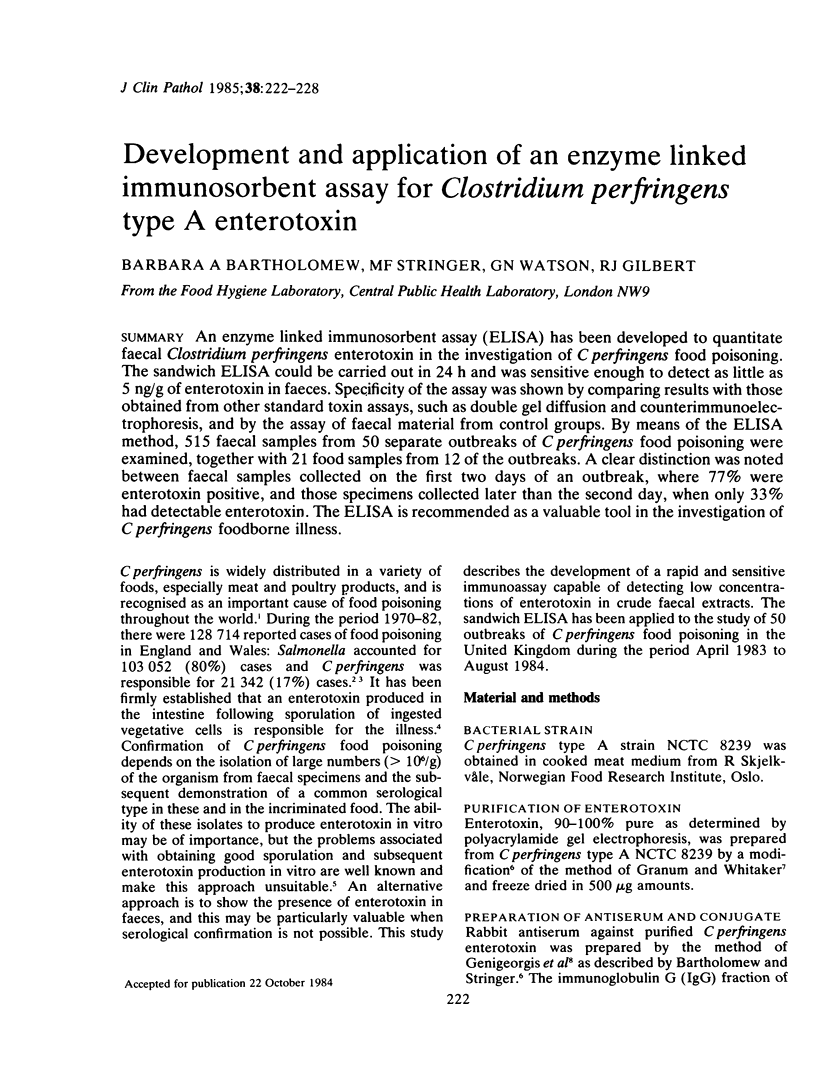
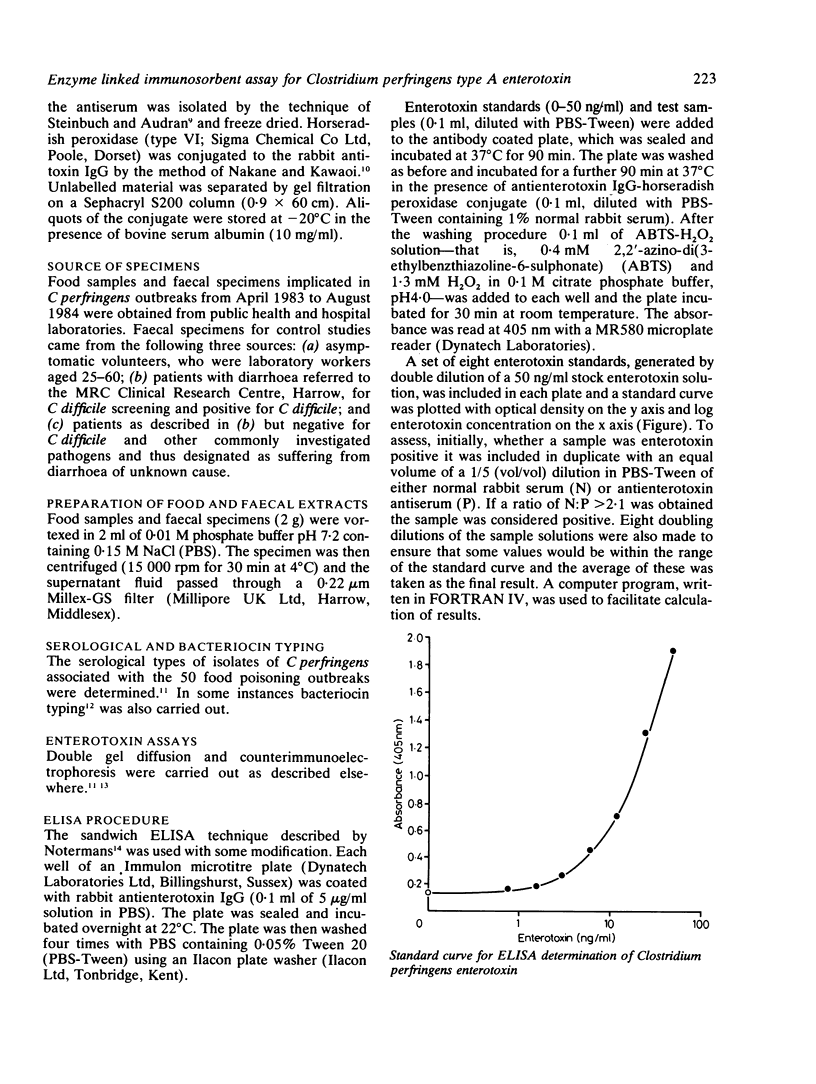
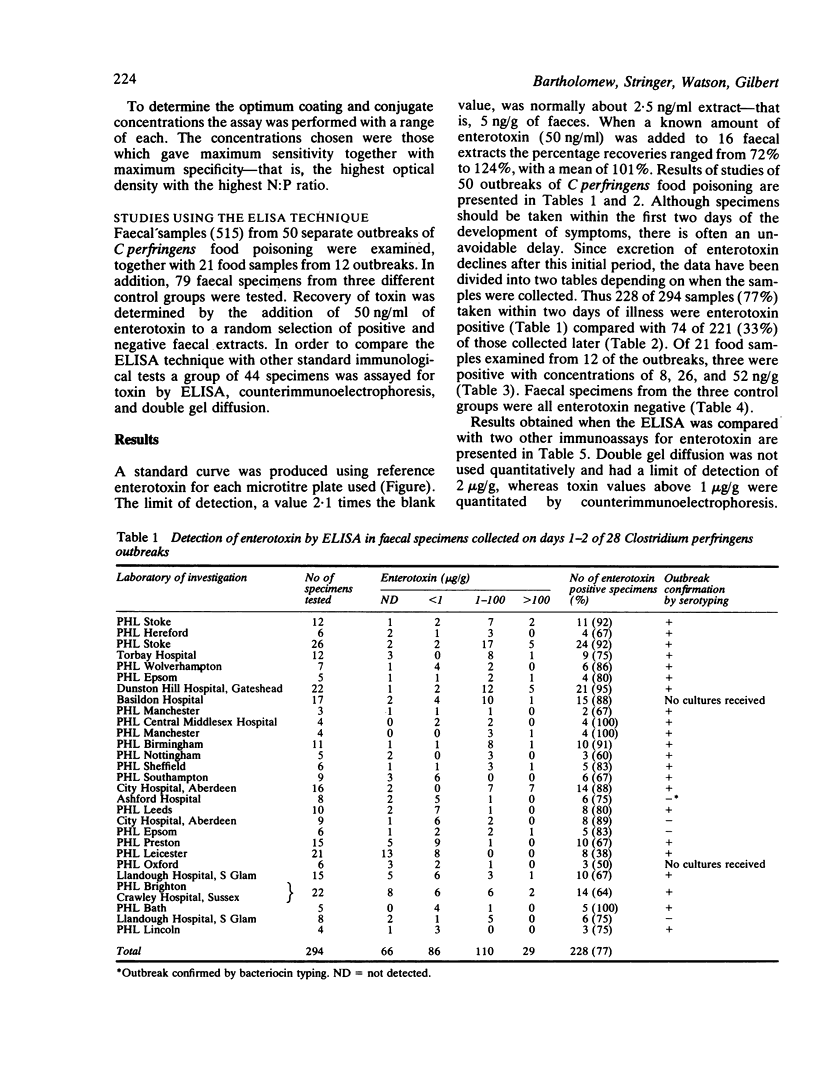
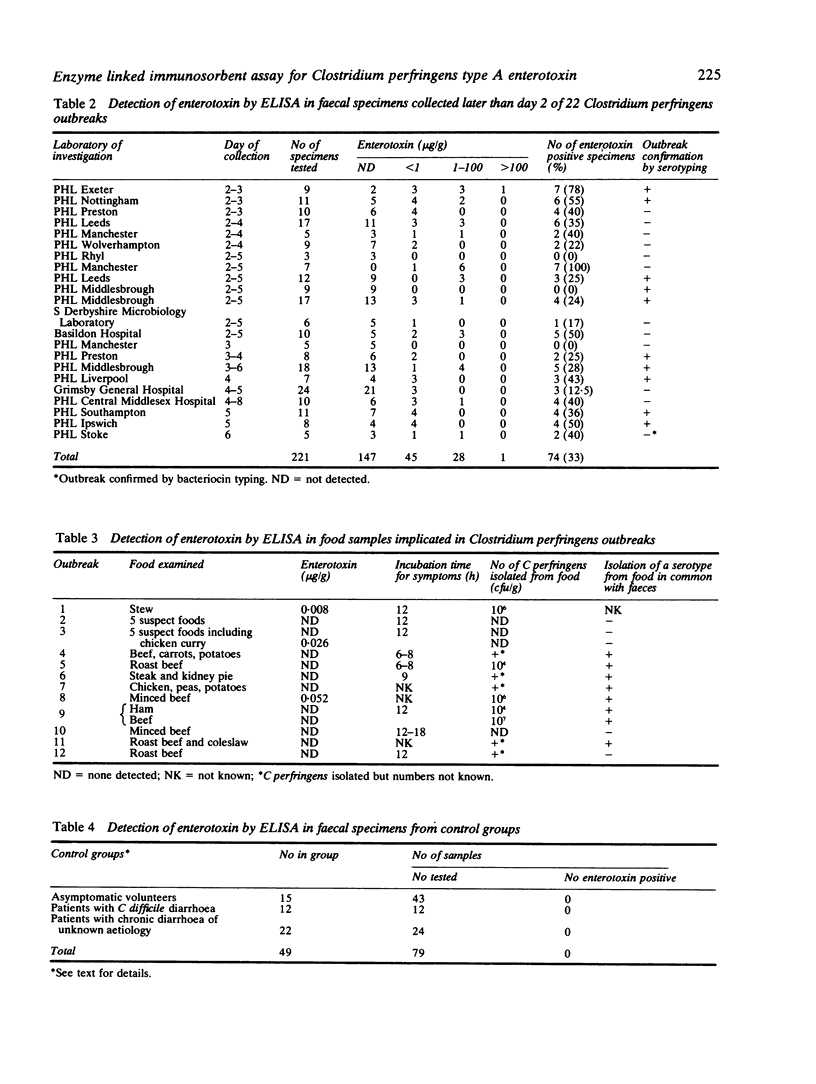
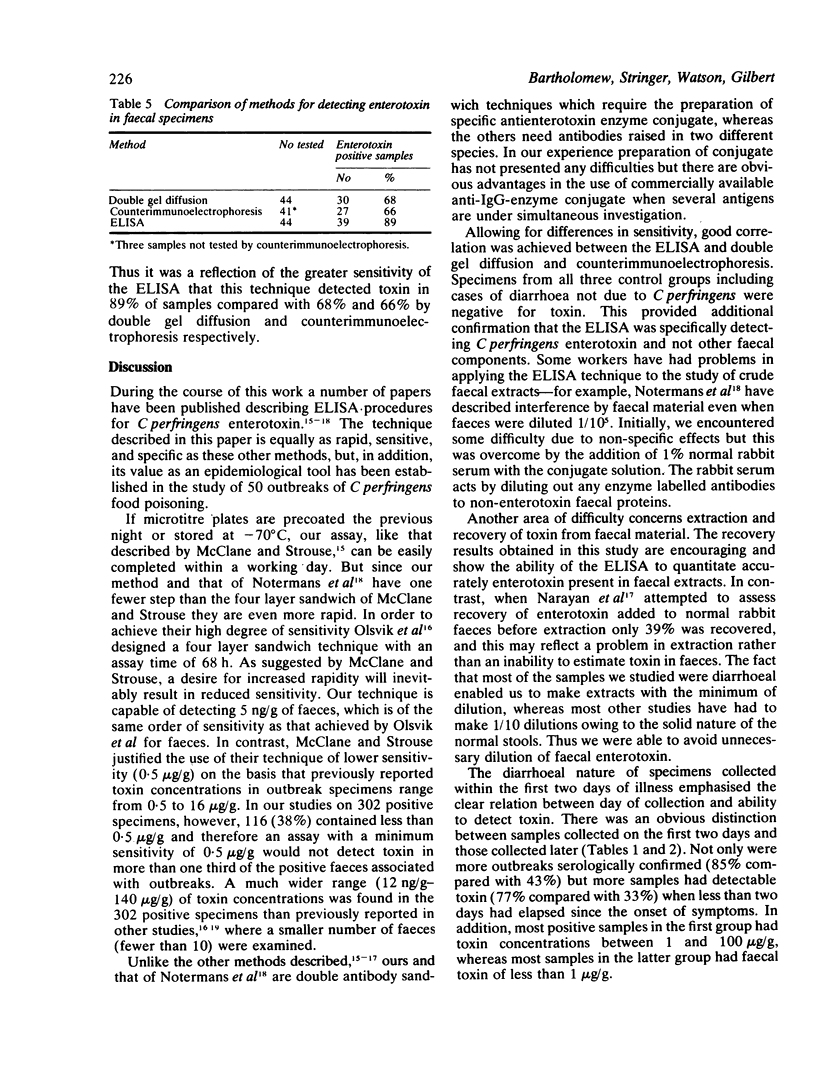
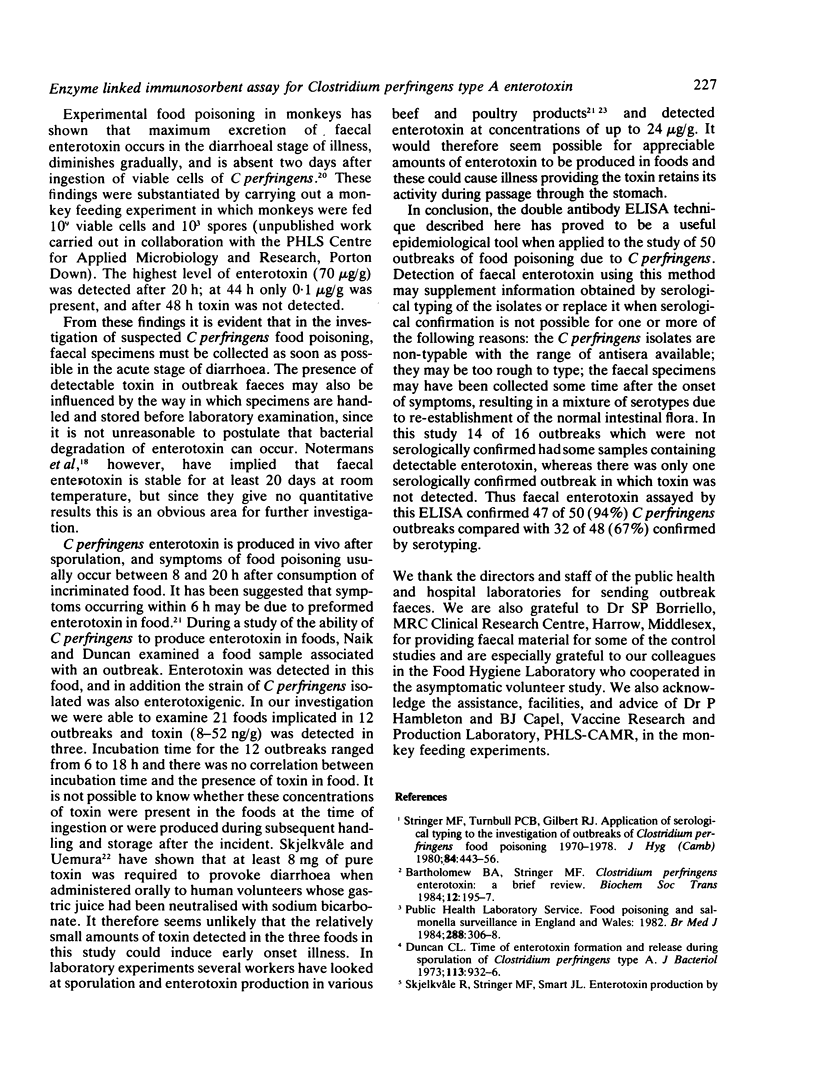
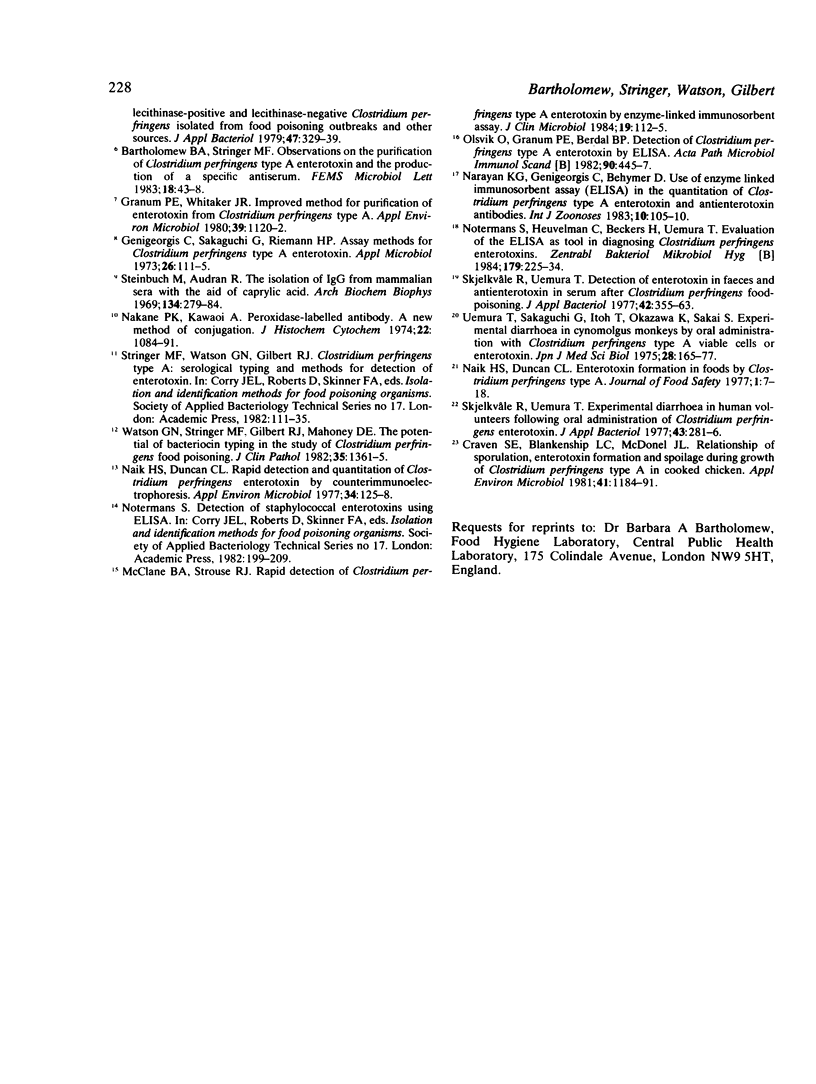
Selected References
These references are in PubMed. This may not be the complete list of references from this article.
- Bartholomew B. A., Stringer M. F. Clostridium perfringens enterotoxin: a brief review. Biochem Soc Trans. 1984 Apr;12(2):195–197. doi: 10.1042/bst0120195. [DOI] [PubMed] [Google Scholar]
- Craven S. E., Blankenship L. C., McDonel J. L. Relationship of sporulation, enterotoxin formation, and spoilage during growth of Clostridium perfringens type A in cooked chicken. Appl Environ Microbiol. 1981 May;41(5):1184–1191. doi: 10.1128/aem.41.5.1184-1191.1981. [DOI] [PMC free article] [PubMed] [Google Scholar]
- Duncan C. L. Time of enterotoxin formation and release during sporulation of Clostridium perfringens type A. J Bacteriol. 1973 Feb;113(2):932–936. doi: 10.1128/jb.113.2.932-936.1973. [DOI] [PMC free article] [PubMed] [Google Scholar]
- Genigeorgis C., Sakaguchi G., Riemann H. Assay methods for Clostridium perfringens type A enterotoxin. Appl Microbiol. 1973 Jul;26(1):111–115. doi: 10.1128/am.26.1.111-115.1973. [DOI] [PMC free article] [PubMed] [Google Scholar]
- Granum P. E., Whitaker J. R. Improved method for purification of enterotoxin from Clostridium perfringens type A. Appl Environ Microbiol. 1980 Jun;39(6):1120–1122. doi: 10.1128/aem.39.6.1120-1122.1980. [DOI] [PMC free article] [PubMed] [Google Scholar]
- McClane B. A., Strouse R. J. Rapid detection of Clostridium perfringens type A enterotoxin by enzyme-linked immunosorbent assay. J Clin Microbiol. 1984 Feb;19(2):112–115. doi: 10.1128/jcm.19.2.112-115.1984. [DOI] [PMC free article] [PubMed] [Google Scholar]
- Naik H. S., Duncan C. L. Rapid detection and quantitation of Clostridium perfringens enterostoxin by counterimmunoelectrophoresis. Appl Environ Microbiol. 1977 Aug;34(2):125–128. doi: 10.1128/aem.34.2.125-128.1977. [DOI] [PMC free article] [PubMed] [Google Scholar]
- Nakane P. K., Kawaoi A. Peroxidase-labeled antibody. A new method of conjugation. J Histochem Cytochem. 1974 Dec;22(12):1084–1091. doi: 10.1177/22.12.1084. [DOI] [PubMed] [Google Scholar]
- Narayan K. G., Genigeorgis C., Behymer D. Use of enzyme linked immunosorbent assay (ELISA) in the quantitation of Clostridium perfringens type A enterotoxin and antienterotoxin antibodies. Int J Zoonoses. 1983 Dec;10(2):105–110. [PubMed] [Google Scholar]
- Notermans S., Heuvelman C., Beckers H., Uemura T. Evaluation of the ELISA as tool in diagnosing Clostridium perfringens enterotoxins. Zentralbl Bakteriol Mikrobiol Hyg B. 1984 Jun;179(3):225–234. [PubMed] [Google Scholar]
- Olsvik O., Granum P. E., Berdal B. P. Detection of Clostridium perfringens type A enterotoxin by ELISA. Acta Pathol Microbiol Immunol Scand B. 1982 Dec;90(6):445–447. doi: 10.1111/j.1699-0463.1982.tb00144.x. [DOI] [PubMed] [Google Scholar]
- Skjelkvåle R., Stringer M. F., Smart J. L. Enterotoxin production by lecithinase-positive and lecithinase-negative Clostridium perfringens isolated from food poisoning outbreaks and other sources. J Appl Bacteriol. 1979 Oct;47(2):329–339. doi: 10.1111/j.1365-2672.1979.tb01763.x. [DOI] [PubMed] [Google Scholar]
- Skjelkvåle R., Uemura T. Detection of enterotoxin in faeces and anti-enterotoxin in serum after Clostridium perfringens food-poisoning. J Appl Bacteriol. 1977 Jun;42(3):355–363. doi: 10.1111/j.1365-2672.1977.tb00703.x. [DOI] [PubMed] [Google Scholar]
- Skjelkvåle R., Uemura T. Experimental Diarrhoea in human volunteers following oral administration of Clostridium perfringens enterotoxin. J Appl Bacteriol. 1977 Oct;43(2):281–286. doi: 10.1111/j.1365-2672.1977.tb00752.x. [DOI] [PubMed] [Google Scholar]
- Steinbuch M., Audran R. The isolation of IgG from mammalian sera with the aid of caprylic acid. Arch Biochem Biophys. 1969 Nov;134(2):279–284. doi: 10.1016/0003-9861(69)90285-9. [DOI] [PubMed] [Google Scholar]
- Stringer M. F., Turnbull P. C., Gilbert R. J. Application of serological typing to the investigation of outbreaks of Clostridium perfringens food poisoning, 1970-1978. J Hyg (Lond) 1980 Jun;84(3):443–456. doi: 10.1017/s002217240002698x. [DOI] [PMC free article] [PubMed] [Google Scholar]
- Uemura T., Sakaguchi G., Ito T., Okazawa K., Sakai S. Experimental diarrhea in cynomolgus monkeys by oral administration with Clostridium perfringens type A viable cells or enterotoxin. Jpn J Med Sci Biol. 1975 Jun;28(3):165–177. doi: 10.7883/yoken1952.28.165. [DOI] [PubMed] [Google Scholar]
- Watson G. N., Stringer M. F., Gilbert R. J., Mahony D. E. The potential of bacteriocin typing in the study of Clostridium perfringens food poisoning. J Clin Pathol. 1982 Dec;35(12):1361–1365. doi: 10.1136/jcp.35.12.1361. [DOI] [PMC free article] [PubMed] [Google Scholar]


